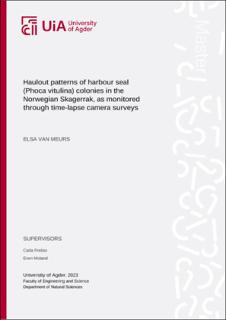| dc.description.abstract | Harbour seals (Phoca vitulina) are a part of the Norwegian coastal ecosystem and are distributed along the coastline, amongst the humans inhabiting and/or visiting these areas. We need to gain a better understanding of how to effectively manage and protect these seals. In this study, time-lapse camera surveys were employed to enhance our understanding of the haulout patterns of harbour seals in the Norwegian Skagerrak. I investigated how these patterns were influenced by environmental parameters, including wind speed, temperature, water level, time of day, and anthropogenic disturbances. Data was collected from cameras installed at the two locations: Lyngør and Østre-Bolærene, during 12 and 4 months, respectively. Temperature (p-value < 0,001) had a significant positive influence on haulout behaviour. Water level (p-value < 0,001) and wind speed (p-value < 0,001) had a negative effect on the number of seals on land. I observed that human presence had an impact on how the seals behaved. This may vary due to the layout of the area and if the area was highly populated by humans in the summer months. This study identified clear circadian patterns in the seals' haulout behaviour during autumn and early winter, with a preference for hauling out during late afternoon, night, and early morning. Previous studies have shown that seal haulout behaviour could be affected by various factors. This study's significant contribution lies in its successful demonstration of using time-lapse cameras to effectively monitor haulout patterns. Overall, this study provided valuable insights into the factors that influenced the haulout behaviour of harbour seals and emphasized the importance of considering environmental factors in understanding the behaviour of marine mammals. This in turn could give us a better understanding on how to correct seal count during the moulting season as well as give us a better understanding on their behaviour. We must take in account that there might be slight changes in the haulout behaviour during the moulting season. | |
